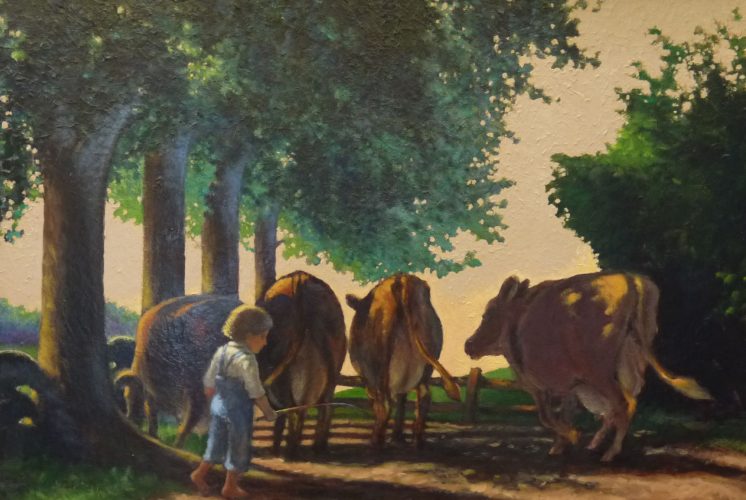The Museum Blog
Category: Books We Love
Family Literacy Month Kick-Off
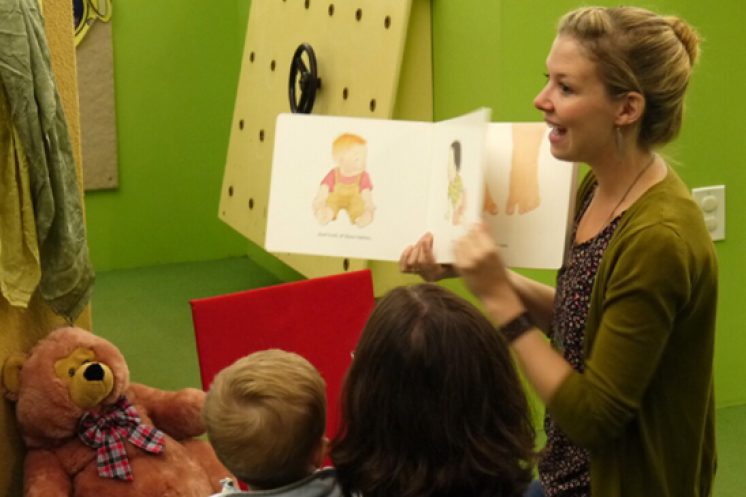
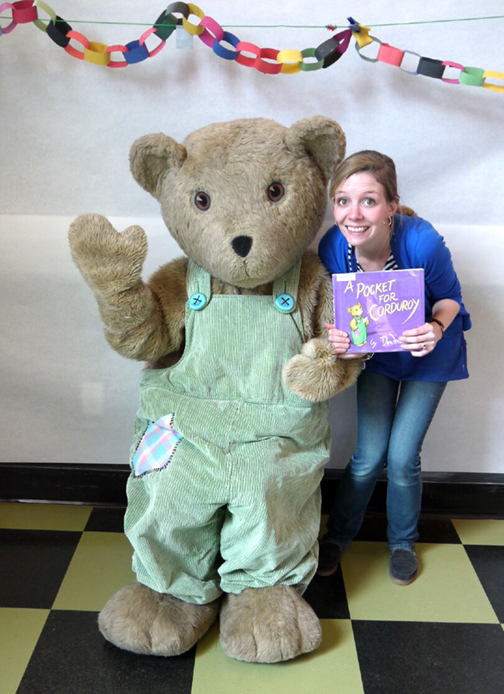 By Meredith Lamothe
By Meredith Lamothe
We’re always excited about literacy here at The Children’s Museum of New Hampshire. Sure, we were thrilled that we were going to celebrate Family Literacy Month this November, but really—we focus on literacy all the time!
We recently hosted a well-attended Jumpstart To Read event; we host Books Alive! events several times a year where costumed characters bring favorite stories to life, and we have weekly Baby Storytimes as part of First Friends Playgroup, where we can teach early literacy skills to the caretakers of our youngest visitors. So a whole month dedicated to literacy? It was a no brainer!
What does family literacy month mean at CMNH?
It means that we’ll have literacy tips posted around that you can peruse as you play. We’ll have multiple activities throughout the week that highlight literacy—and how easy it is to promote and explore at home. We’ve also made up some great handouts, have several guest speakers planned, and will have weekly crafts and games in our Muse Studio—all related to literacy!
We also have our museum. Our museum is a literacy gold mine! Literacy goes so far beyond reading books. Yes, that’s an important part—but literacy, specifically family literacy, is so easy to incorporate into your daily life—or your museum visit!
When you’re playing with your kids in the submarine—make it a story. Does that story have a beginning, middle and end? DING DING DING! LITERACY ALERT! Choose a favorite color when you walk in the museum and then as you play, find that color in each of the exhibits! DING DING DING! Visit the Muse Studio and have your child explain to you the steps they’re taking in making a craft or playing with the magnet table! DING DING DING!
Any conversation, any question, any exploration can easily be made into a rewarding literacy experience. If you have questions, we’re happy to help.
We’re always excited about literacy!
About the Author: Lead Educator Meredith Lamothe has always been a book nerd, library lover and fan of acting out and telling silly stories. She has a blast hosting the Museum’s weekly First Friends Playgroup and has her Master’s Degree in Library and Information Science with a focus in Children’s Programming from Simmons College.
"Of Beauty and Beasts" Illustrator Interviews
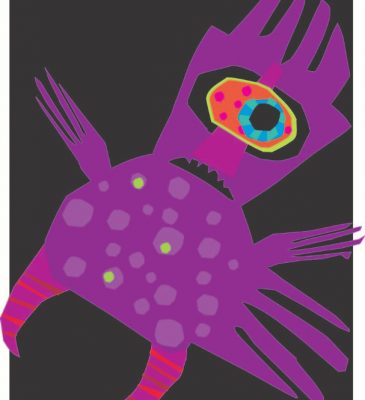 The illustrators from the summer 2015 Gallery 6 exhibition "Of Beauties and Beasts" answered some of our questions about their style of illustrating, from where they get their inspiration and more! The exhibit is on view in the Children's Museum of New Hampshire through Sunday, September 6.
The illustrators from the summer 2015 Gallery 6 exhibition "Of Beauties and Beasts" answered some of our questions about their style of illustrating, from where they get their inspiration and more! The exhibit is on view in the Children's Museum of New Hampshire through Sunday, September 6.
Rebecca Emberley
Q. Your beasts from Ten Little Beasties are such great combinations of fangs and fur. Did the process of collage allow for some fun experimenting when creating these creatures?
A. Collage is a very forgiving art form and allows for lots of experimentation in any genre, but beasts are particularly fun! There are no limits to fangs, scales and horns!
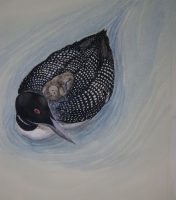 Karel Hayes
Karel Hayes
Q. In what way have your own favorite childhood books influenced you art today?
A. One of my favorite books from my childhood was a 1932 edition of Robert Lewis Stevenson's A Child's Garden of Verses. I found it in a second hand bookstore when I was about ten years old. Second hand bookstores were favorite places for my family to visit. I was first attracted to the book by the wonderful watercolors by Juanita C. Bennett. She was not as well-known as Jessie Wilcox Smith, but I think her work rivaled that well-know artist.
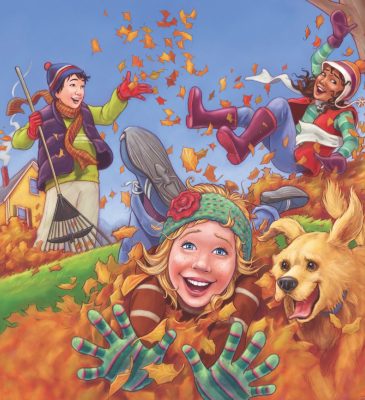 Robert Squier
Robert Squier
Q. Your illustrations are done in “digital media” but the results look very traditional. What inspired your style of illustration?
A. I'd like to think my illustration style is still evolving! My earliest influences were Marvel comics and MAD magazine. When I started working professionally, I worked as a freelance commercial illustrator; that required me to be a chameleon, adapting my style to many different clients' needs.
When I made the transition to illustrating for children, I concentrated on traditional media like watercolor, acrylics and color pencil. I started working digitally out of necessity. Many of the projects I was working on required speed and flexibility – a digital illustration is easier to edit than an acrylic painting. My earliest digital work looked "computery," but over time I've learned to work in a manner that looks more traditional. I prefer a more traditional look because it allows me to bring in the texture, layers of color, and lively line that I developed during years of working in traditional media. But doing the work digitally allows me to work more quickly and allows for easier editing.
For most pieces, my process includes both digital and traditional techniques. For example, I might do a pencil sketch, scan it, tweak it on the computer, print it out, add shading and texture to the printout using an ink wash, scan it again, and then add color and additional texture on the computer.
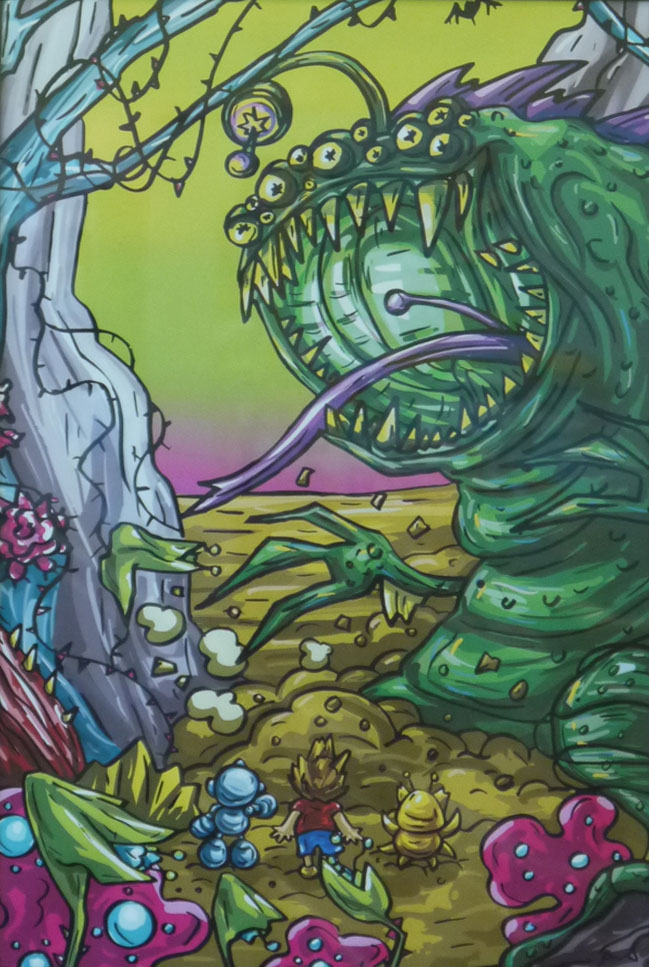 Emily Drouin
Emily Drouin
Q. Your art features some truly terrifying “Beasts.” Where do you get inspiration for these monsters?
A: Ever since I was a child, I've had a passion for illustration and storytelling, and love drawing monsters and robots! I am inspired by those countless trips to the library as a child, such books by Roald Dahl, Maurice Sendak, Chris Van Allsburg, Lewis Carroll, comics such as Calvin & Hobbes, Peanuts, Disney Adventures, and from Jim Henson movies and shows like Star Trek, Invader Zim, Futurama, Dr Who, Farscape and Stargate.
David McPhail
Q. Your two styles of illustrating, pen and ink and acrylics, are very different from each other. Do you find that one lends itself better to portraying “beauty” or “beasts”?
A. Nearly ALL of my books were done in pen and ink, and watercolor. A few are PENCIL and watercolor. Every few years, I feel the urge to "paint," to stand at an easel and apply gobs of paint to a canvas or board. Often, this desire to paint, coincides with a book illustration project that lends itself nicely to the medium. Edward and The Pirates, for example or Farm Boy's Year. When this "convergence" happens I get out my box of acrylics and I prepare some boards with a mix of white gesso, and Burnt Umber paint. I don't like to paint on a WHITE surface. It is much too stark for me. I prefer to paint on a mid-range tone, that way I can make SOME things darker and then bring the "lights" forward. When all is ready, I begin.
Unfortunately, a three or four year gap between "painting" projects, leaves me rusty, and unsure so it takes a while to get up to speed. Sometimes, by the time the book is finished, I feel that I'm just beginning to get the hang of it! But deadlines must be met! Of the nearly 200 books that I have illustrated, fewer than ten were done with "paint."
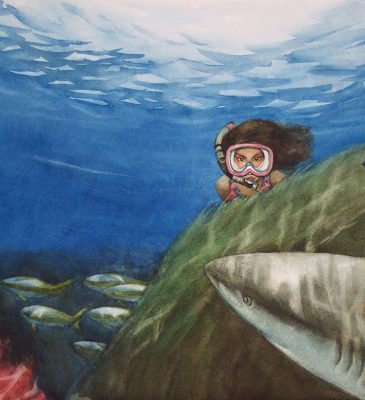
Yong Chen
Q. Most of your illustrations in the exhibit seem to focus on the “beauty” around us such as family, tradition, friends and even the underwater scene with the sinister looking shark is beautiful! Are there unexpected challenges when it comes to creating scenes of beauty?
A. Thank you for seeing my art in such perspective. Actually my goal of making art for children is to build connections of love, respect, curiosity and understanding between different cultures, and in large, between each individual person - us. I admit, I appreciate all the beauty around us, and perhaps that's why I naturally express how I see them in my paintings, but that is not the reason I make art. For example, the book Swimming with Sharks came to me when I didn’t understand much about sharks. After I read the manuscript, I upgraded my understanding of the universe, and how much we rely on the balance and health of the earth. I turned to passion to express my new ideal. Because I was afraid of sharks as I grew up, then I turned to respect the shark as an equal member of our living environment as a beautiful creature. When I worked on the illustrations for this project, I related these mixed feelings as I tried to communicate with my audience. If I just to create scenes of beauty, I may not have problems. But the trick is how to use beauty to educate my audience with messages so that they will accept, and that is not an easy task.
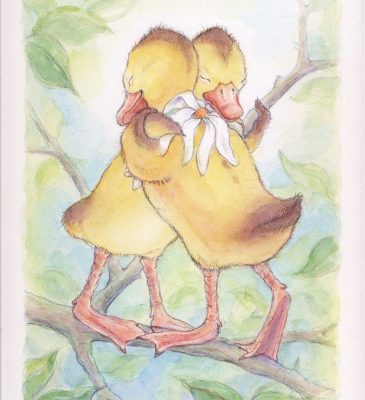 Teri Weidner
Teri Weidner
Q. For people who have never tried to illustrate a children’s book, it might seem like a simple process. But your work goes through many edits and alterations before being finalized. Do you ever find that the process is tiring or is it all a challenge you’ve come to embrace?
A. I think illustrating a picture book is a sort of marathon. It can be a long, difficult process drawing 32 pages, but the format offers an amazing opportunity to tell a visual story. I start all my books knowing that the first round of sketches will probably change dramatically by the time I start the final color artwork. I really enjoy the process of reworking and refining the imagery. Most of my books go through at least 5 rounds of sketches, some initiated by me, some initiated by the editor and art director. My experience with publishers has varied dramatically from book to book. I've had some publishers that gave me almost no feedback beyond "This looks great!", even when I knew my drawings were still far from adequate. In those cases, I've continued to work on improving the sketches on my own, until I was also happy with the results. My favorite way to work, though, is with editors and art directors who can help me hone the imagery, and who offer up creative and clever ways to improve my sketches and make the book stronger. Occasionally I don't agree with their comments (which can be frustrating) but after a day or two of stewing I can usually begin to see where they're coming from and use their ideas as a spring board to improve the illustrations. Even with criticism I think is way off base can be helpful, because it forces me to define which direction the visual story is going, and defend my choices. If I can't defend them, then the pictures really do need to be reworked! So yes, sometimes the editing process can be tiring, but over the years it's something I've come to embrace. If it leads to a better book, it's worth all the effort!
Sean Bixby
Q. You have such a fun variety of creatures in your illustrations from The Uncrossable Canyon books. I imagine your sketchbook as being filled with drawing experiments. Is the planning/sketching phase the most fun for you or do you prefer working on the final illustration?
A. The planning and sketching phase are really fun to me. For The Uncrossable Canyon series, the author had many fantastic characters written into the story who were fun to design. There were also many other characters that I was able to create myself. There is a lot of brainstorming and experimenting in the process of coming up with characters. For crowd scenes I filled them with some of my favorite animals, including my dog, my favorite monsters and dinosaurs. I even looked at sketchbooks from when I was young and redesigned some of the characters I had created years ago. I have to focus a lot during this phase as I am constantly drawing and revising the characters and also the layout of the final illustration. It’s once I have the drawing down on the final paper that I can start to relax a bit more. When I start to paint, my mind is a little more free and I can listen to music, movies or podcast. So with all this said I would say have no preference as each part of the process is unique and challenging in its own way.

